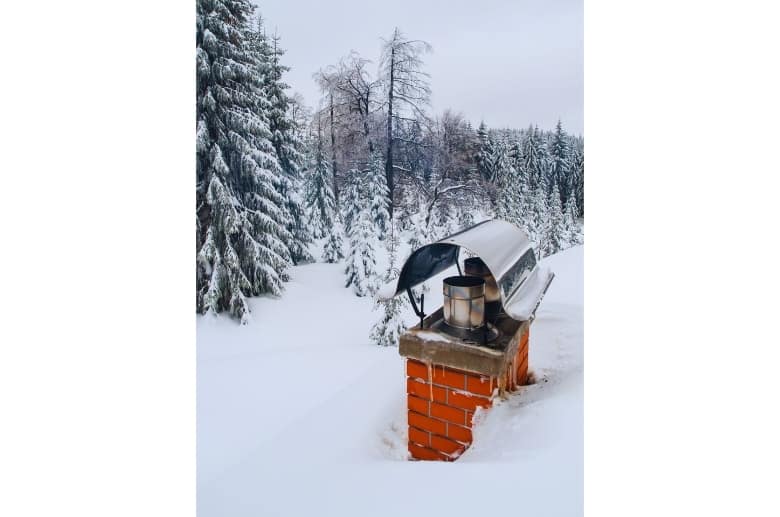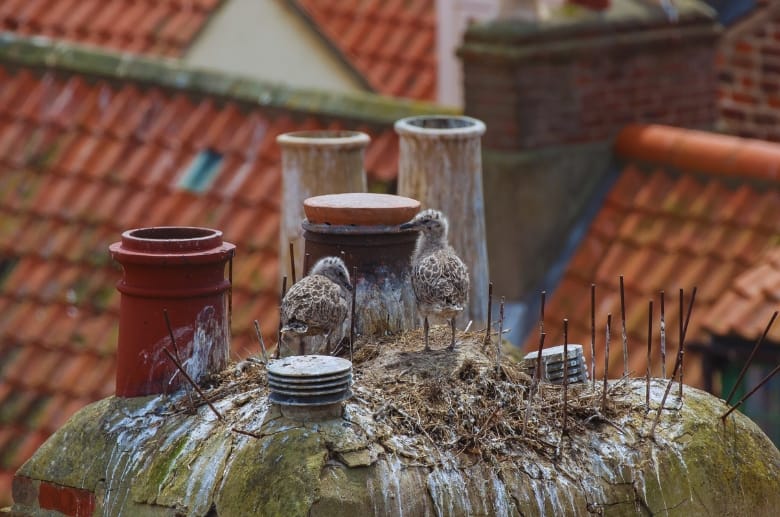One of the main reasons your chimney chase cover leaks is often traced back to an initial improper installation, wear and tear, or environmental causes.
A chimney chase cover is an essential component of a prefabricated chimney system. It shields the chimney’s structure from harm and ensures its longevity.
However, chimney chase covers can develop leaks over time, compromising their effectiveness. This guide will help you understand how to tackle chimney chase cover leaking and how to avoid the problem in the future.
Common Causes of Chimney Chase Cover Leaks
Chase cover leaking is usually attributed to environmental factors, improper installation, and wear and tear. When comparing chimney crowns and chase covers, it becomes evident that each has its unique vulnerabilities and functions. Understanding these differences can aid in pinpointing the root causes of issues and ensuring the right preventive measures are in place.
Weather and Environmental Factors

Exposure to harsh weather conditions often causes chimney chase covers to leak. Rain and snow can seep through cracks or gaps in the chase cover. This leads to water damage in the chimney and inside your house.
With sudden changes in weather conditions, like very hot summers and freezing winters, the materials of the cover, such as steel or aluminum, can expand and contract, making existing cracks worse. This creates more chances for water to get in.
Poor Installation
Improper installation techniques can result in chimney chase cover leaks. Common errors include gaps between the cover and chimney, incorrect shape or size, and inadequate sealant application. These issues create openings for water to enter and cause leaks.
If a chimney chase cover has been installed incorrectly or constructed using lower-quality materials, the need for replacement could arise within five years or so.
——
Do You Need to Hire Chimney & Fireplace Expert?
Get free quotes from qualified experts near you. No commitment required!
——
Wear and Tear
Chimney chase covers, like any other component, can deteriorate over time due to age and wear. Signs of wear and tear include rust, dents, or holes in the cover.
When homeowners neglect to maintain their chase covers, it can lead to problems such as flue damage, roof damage, and increased risk of chimney fire.
One noticeable indication that your chimney chase cover might require replacement is the presence of water inside the firebox.
Although the source of the leak could be from a different part of the chimney system, it’s advisable to consider the chase cover as a potential source if water is dripping into the fireplace. If you’re unsure what to do, you can call a professional to diagnose the chimney chase cover leaking source
Effects of Chimney Chase Cover Leaks
Leaks in chase covers can result in various harmful consequences for your home, including structural damage. When this occurs, the regular freeze and thaw cycles in the environment lead to repeated expansion and contraction within the masonry. This process initiates deterioration, which can persist until the chimney crumbles.
Various adverse effects of chimney chase cover leaks include:
Water Damage

When water gets inside the chimney chase cover through a leak, it can cause damage to the chimney’s interior and the area around it. If left unaddressed, this can result in water stains, mold growth, and even structural issues.
Molds can create spores that cause respiratory problems in some people. If you breathe or touch mold or its spores, you might get symptoms like sneezing, a runny nose, red eyes, or a skin rash, especially if you are sensitive to it.
Many people in the U.S. test positive for mold allergens but don’t have any symptoms. Research shows that it could be as low as 3 percent or as high as over 90 percent.
Therefore, regular chimney inspections are crucial to identifying and rectifying leaks and preventing molds.
Pest Infestation

A chimney chase cover that’s damaged or not properly installed can provide access for various animals, including birds, squirrels, raccoons, and even bats, to enter your chimney.
These animals can cause harm as they can leave droppings or create nests and potentially make their way into your home, creating safety and health concerns. Furthermore, this could lead to blockages, backdrafts, and other issues affecting your chimney’s performance, eventually leading to fire.
Decreased Energy Efficiency
When covers have leaks or gaps, they can mess with how energy-efficient your home is. It’s kind of like having tiny doors that let air sneak in and out between the chimney and outdoors, which can bump up your energy bills.
What to Do About Chimney Chase Cover Leaks
As a homeowner, when you are experiencing chimney chase cover leaks, here are some practical steps and helpful solutions to fix them right away and prevent further damage.
1. Regular Chimney Inspection and Assessment
Conducting regular chimney inspections is crucial for detecting leaks early on. You will want to look for the following signs to know that your chase cover is leaking.
- Internal Indicators: When you check your chimney’s interior, make sure to look for moisture in the fireplace, water stains, damage on walls and ceilings nearby, and any strange smells. This may indicate that there is mold or mildew, which can be harmful to your health.
- External Indicators: Outside of your home, look for rust on the chase cover or chimney cap, water gathering near the chimney on the roof, and cracks in the bricks or masonry. Paying attention to these signs will help you find any problems before they get worse.
If you’re uncertain about the extent of the damage or require a comprehensive inspection, seek guidance from a skilled chimney technician. Their expertise enables them to effectively identify and assess any issues with your chimney chase cover.
2. Repair Methods
If you have failed to maintain your chase cover, it will likely need repairs. Repairs can be classified into two options.
- DIY repair: If the chimney chase cover has minor leaks, you can try DIY repairs using proper sealant or silicone designed for chimney use. Keep in mind that this will only last temporarily, and you still need to contact a professional in the future.
- Professional repair: If the leaks are more serious or if there’s structural damage from the start, it’s better to get help from a professional chimney technician. They know how to properly check the damage and suggest the right repairs.
In some cases, the chase cover might need replacement. A professional chimney technician can help you with selecting the right replacement cover. They will consider factors like the material, size, and weather resistance to find the best fit for your chimney.
3. Replacement of Chase Cover
Chimney chase covers usually last about 15-20 years. Factors like weather, moisture, and how well it’s taken care of can make a difference in how long it lasts. If you notice rust, cracks, water stains, or damage, it’s a sign that you need a new chimney chase cover.
To replace the cover, you will need to measure the chimney’s width and height using a tape measure. Measure both sides of the chimney diagonally to confirm symmetry. Then, find a chase cover material, such as stainless steel or aluminum, that fits your budget.
Be aware that the steps for replacing a chimney chase cover can differ based on design and materials. If you’re uncertain about any aspect of the installation process, refer to manufacturer instructions or seek the assistance of a professional.
Chimney Maintenance to Prevent Leaks
To prevent chimney chase cover leaking, regular maintenance is key. Here are our tips on preventative measures homeowners can take:
1. Routine Care and Maintenance

The National Fire Protection Association suggests a minimum of one annual cleaning per year. This will help prevent water damage, avert rust and discoloration, uphold chimney efficiency, and deter the intrusion of animals. However, the frequency of cleaning should be determined based on the chimney’s usage.
If you want to go the DIY route, here are the things you need to do.
Check the cover for early signs of rust or damage by keeping an eye out for reddish-brown stains along the chase cover’s sides. This indicates the potential presence of rust in hidden areas of the chase cover. The rust may begin to trickle down during rainy conditions, so address the problem immediately.
Then, inspect and maintain the chimney caps and flashing periodically to ensure a tight seal.
2. Upgrading Materials and Equipment
Think about improving your chimney chase cover by using materials like copper or higher-grade stainless steel. These materials last longer and are more resistant to rust. The average price of a copper chase cover ranges from $900 – $1,200, whereas a stainless steel cover is priced at $300 – $700, which makes it a more cost-efficient option.
You can also invest in good chimney caps and liners for better protection against leaks.
Finally, insulating the chimney prevents ice formation during cold weather. As warm indoor air rises through the chimney, inadequate insulation can cause it to meet cold chimney walls, leading to moisture turning into ice. Proper insulation retains warm air indoors and prevents ice buildup.
3. Chimney Waterproofing
Waterproofing your chimney adds an extra layer of protection to prevent leaks. To waterproof your chimney, here are the steps you need to take.
Begin the process by having a chimney technician apply an outer waterproofing layer to your chimney. Additionally, they can incorporate a waterproof membrane for added protection. Ask your contractor what waterproofing solutions they offer.
Conclusion
Summing up the significance of addressing chimney chase cover leaks, it’s crucial for homeowners to prioritize regular inspections and choose quality materials for repairs. By doing so, you can safeguard your chimney’s structural integrity and ensure the safety and efficiency of your home.
Keep in mind that making sure your chimney is safe and working well is something you could do yourself but is not recommended. To get your chimney back in good condition, it’s best to ask a professional chimney sweep for help.






